We’re in the heart of the largest event in the ceramic and natural stone industry, another words: the Coverings 2024 Trade Fair. Ahead of us, interesting meetings and get-togethers, countless inspiring conversations, lots of shows and presentations! Visit our showcase to see what the Cerrad Group has in its offer of ceramic tiles. Come and see what we’ve prepared for you. We’ll be waiting for you on April 22-25!


Cerrad Group stand – 8136/HALL C
Georgia World Congress Center
Atlanta, Georgia
Last week, we had the pleasure of hosting a delegation from Germany. Among the guests were representatives from one of the most important industry magazines in Germany, 1200 Grad, as well as tilers and architects.
The visit to Starachowice included a presentation of our modern factory, which boasts the latest Lamgea production line for large-format slabs. Our guests had the opportunity to learn about our newest production technologies and observe the process of cutting large-format tiles during a specially prepared demonstration.
As part of the visit, they also toured the capital and our Warsaw showroom, where we presented our latest collections, which were well received. It was a wonderful opportunity for us to exchange experiences, establish new contacts, and jointly draw inspiration from industry trends.
We believe that such meetings will further strengthen our international cooperation and open new perspectives for the future.
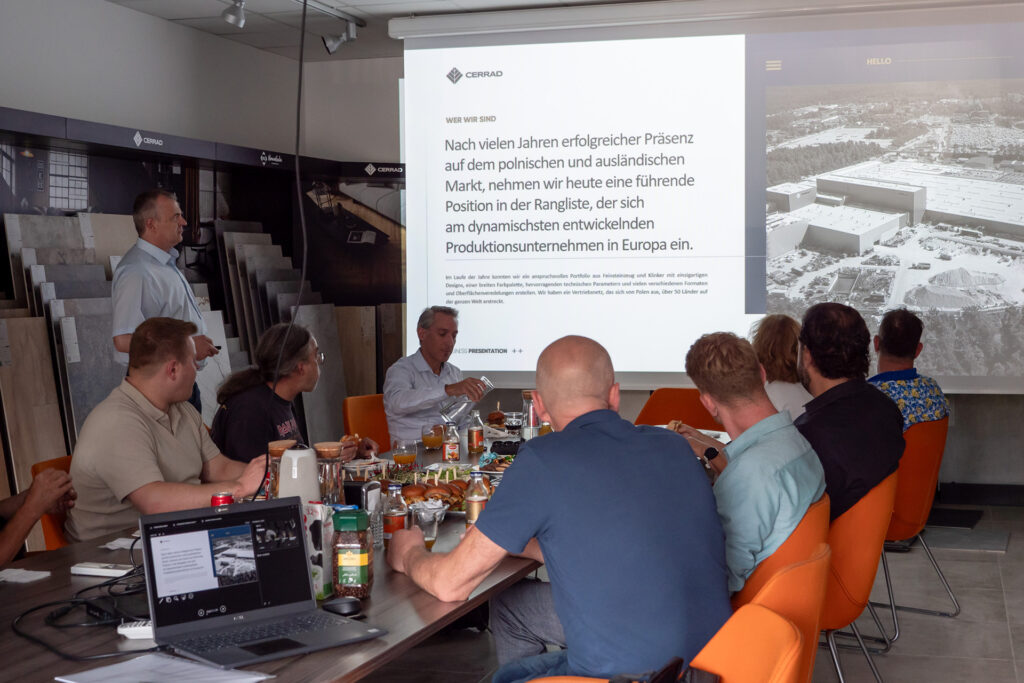

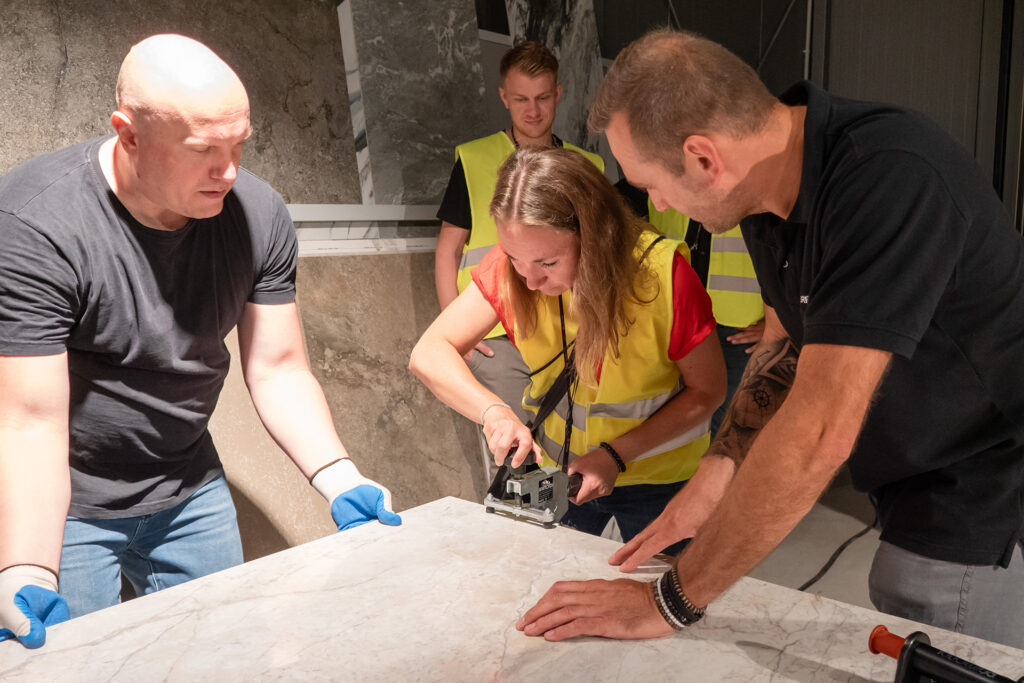
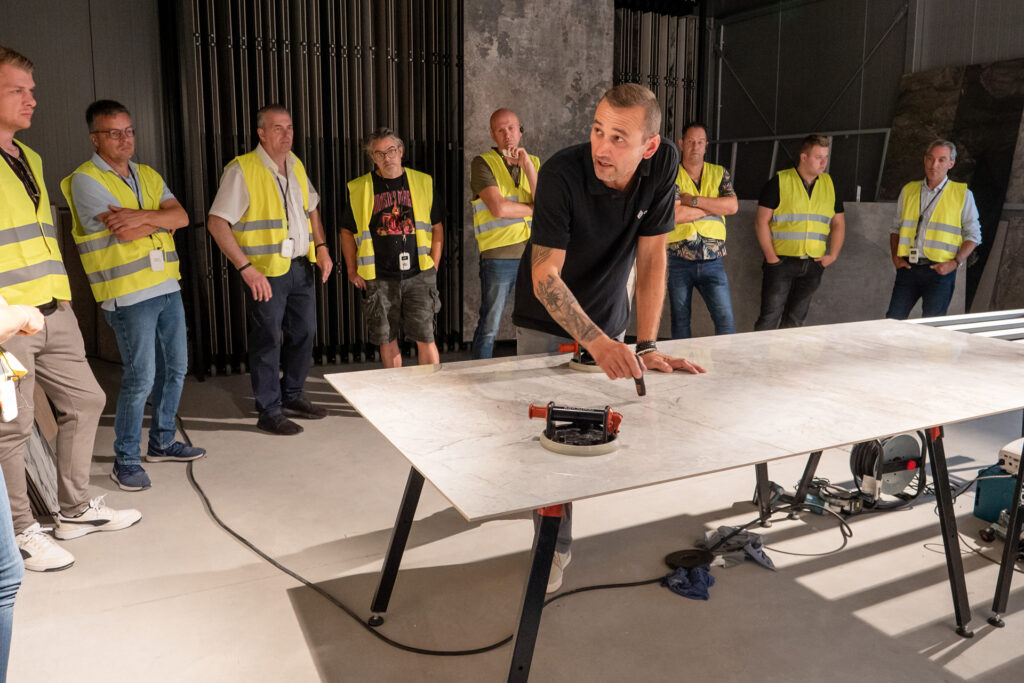
Ceramic tiles, alongside wood, are among the most commonly chosen materials for flooring. They are successfully used not only in kitchens and bathrooms but also in hallways and on stairs, where they provide exceptional durability. What kind of ceramic tiles should you buy for indoor stairs to ensure both durability and an elegant look?
Tiles for Indoor Stairs – Is It a Good Idea?
Homeowners considering finishing materials for their homes or apartments often wonder if ceramic-tiled stairs are truly a good choice. From both aesthetic and economic perspectives, tiles tend to outperform wood, and the reason is simple. Ceramic tile stairs are primarily more affordable than wooden ones, even when choosing high-quality tiles. Tiles that imitate stone or wood can look so realistic that they are nearly indistinguishable from natural materials, making the cost savings even more justified.
Ceramic tile stairs can also be completed much faster, while offering greater durability and ease of maintenance. Such stairs require no additional care, unlike their wooden counterparts, and time does not leave its mark on them.
Modern tiles for indoor stairs are produced in lengths and widths that fit typical stair dimensions, making it easy to install them without excessive cutting and additional grout lines that could detract from the aesthetic appeal of the design.
How to Choose Ceramic Tiles for Indoor Stairs?
To fully benefit from ceramic tile stairs, it’s important that the tiles themselves have the appropriate mechanical and chemical resistance. Several different types of ceramic tiles are available on the market: anti-slip, matte, polished, textured, and glazed. For stairs, anti-slip tiles with a textured surface are best. These tiles can imitate both natural stone and wood.
Before purchasing, it’s also important to check whether the selected products are marked as resistant to detergents. Resistance to chemicals will allow you to clean the floor with commonly used cleaning agents containing anionic and cationic surfactants.
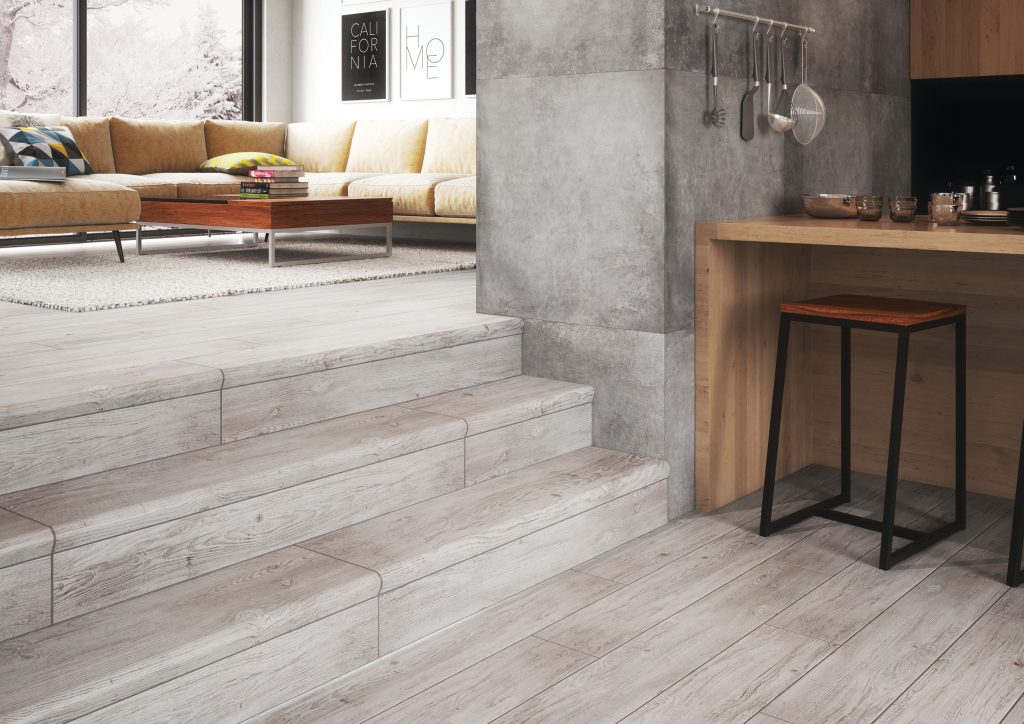
What Tile Parameters Should You Consider?
For indoor stairs, frost resistance is not necessary, but the wear resistance rating is crucial. Stairs are a heavily used surface, so it’s best to choose tiles with a wear resistance class of PEI4 or PEI5 and an anti-slip rating of R10-R11.
It’s also important to consider the bending strength according to ISO 10545-4. Stairs will be subjected to heavy loads, so higher bending strength will ensure greater durability. It’s best to choose tiles with a minimum bending strength of 27 MPa, ensuring the stairs can withstand greater stress.
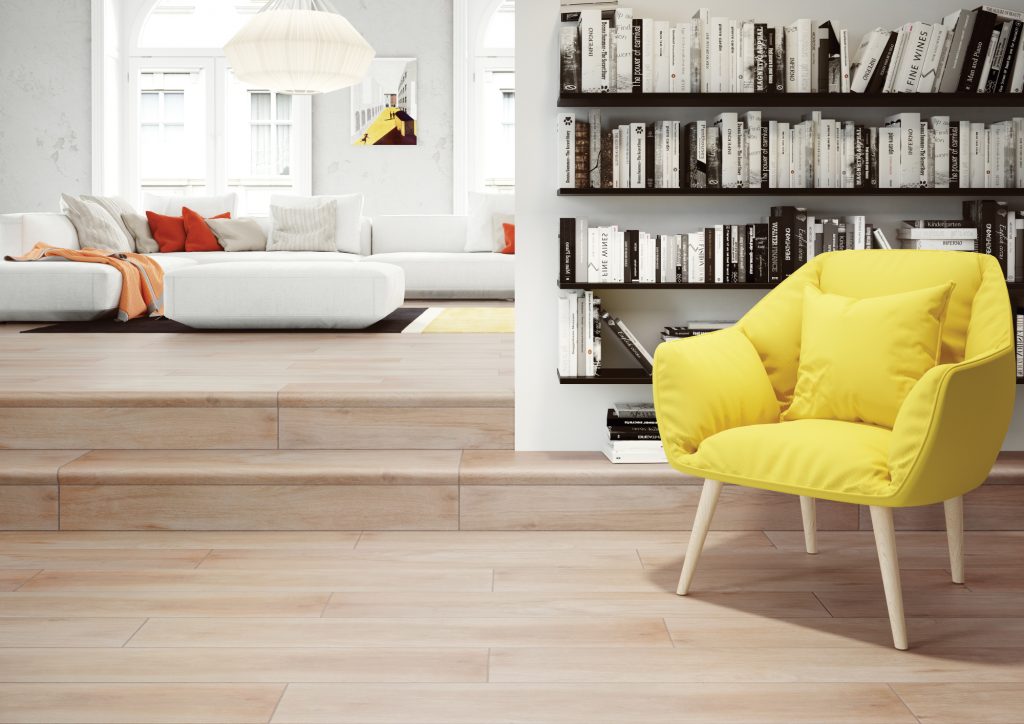
Light or Dark – Which Tiles to Choose for Indoor Stairs?
The color and pattern of the ceramic tiles are purely an aesthetic choice. Light-colored tiles visually enlarge the space and give a sense of openness and cleanliness, but they also tend to show dirt more easily. Light ceramic tiles are very versatile, making them suitable for both small and large rooms, while dark tiles are better suited for spacious interiors where you don’t need to worry about making the space look smaller.
Monochromatic indoor tile stairs without distinct patterns can look very elegant, but there is a risk that dirt will be more noticeable. On the other hand, tiles with irregular patterns mimicking natural wood grain or stone veining will help conceal dust or small particles of dirt.
Installing Ceramic Tiles on Stairs – Is It a Big Challenge?
Achieving the desired level of aesthetics and durability for ceramic tile stairs requires knowledge and skill. The final result largely depends on the installation method and the precision of the professional laying the tiles.
Two types of tiles are typically used on stairs – specialized step tiles with anti-slip grooves for the treads and smooth standard tiles for the risers. Ceramic tiles are adhered to the stairs using special adhesives for ceramic tiles. The surface needs to be cleaned and primed, followed by an even layer of adhesive spread across the surface and on the tiles themselves. The tiles are then laid one next to the other, ensuring they are properly leveled. During the installation, it is crucial to fill the space between the substrate and the tiles thoroughly, as any gaps may lead to cracks. After the adhesive dries, the tiles are carefully grouted, cleaned, and the grout lines are sealed.
Indoor ceramic tile stairs can be both aesthetically pleasing and durable. Solid ceramic tiles have such high mechanical, chemical, and thermal resistance that they will maintain their flawless appearance for many years. The key is to choose the right product and apply it skillfully.
Beige BathroomChoosing beige tiles for the bathroom is a decision that brings a timeless style and subtle elegance to the space. Beige bathroom tiles embody natural tones, offering immense possibilities for arrangement. They create a warm, harmonious space conducive to relaxation.
Advantages of a Beige Bathroom
A beige bathroom works well in any style – from minimalist and Scandinavian to glamour. Beige is a neutral color that easily combines with other colors and textures, making it an ideal base for accessories in black, graphite, or gold. An additional advantage of beige bathroom tiles is their ability to visually expand the space. Light shades make the bathroom seem more spacious – perfect for both large and smaller bathrooms.
Cerrad Beige Tiles – Elegance and Functionality
The Cerrad brand is known for high-quality tiles that combine beauty and functionality. Cerrad collections include bathroom tiles in various sizes and surface finishes, including large-format and textured tiles, allowing for unique arrangements.
The Cerrad Dignity Beige collection is a perfect choice for lovers of stone-inspired patterns. Bathroom tiles in this collection reflect the beauty of natural stone. The Dignity Beige collection offers harmony and elegance that introduce a natural, timeless character to any bathroom.
Cerrad also offers large-format 120×280 tiles, which are ideal for modern bathrooms, giving a spacious impression.
Cerrad x La Mania Home – Luxurious Solutions for an Elegant Bathroom
The Cerrad x La Mania Home collection combines classic elegance with modern style. Beige tiles from this line: Modern Concrete Beige are stoneware that imitates concrete, featuring a raw charm in a warm tone, making them an ideal solution for bathrooms with a modern character.
Arrangement Inspirations with Beige Tiles
1. Minimalist Bathroom with Textured Beige Tiles
Matte, textured bathroom tiles from Cerrad in beige tones will give the interior a modern, industrial character. Perfect additions are black or graphite accessories, such as fittings or handles. Matte bathroom tiles resembling natural stone or concrete work excellently with a minimalist style.
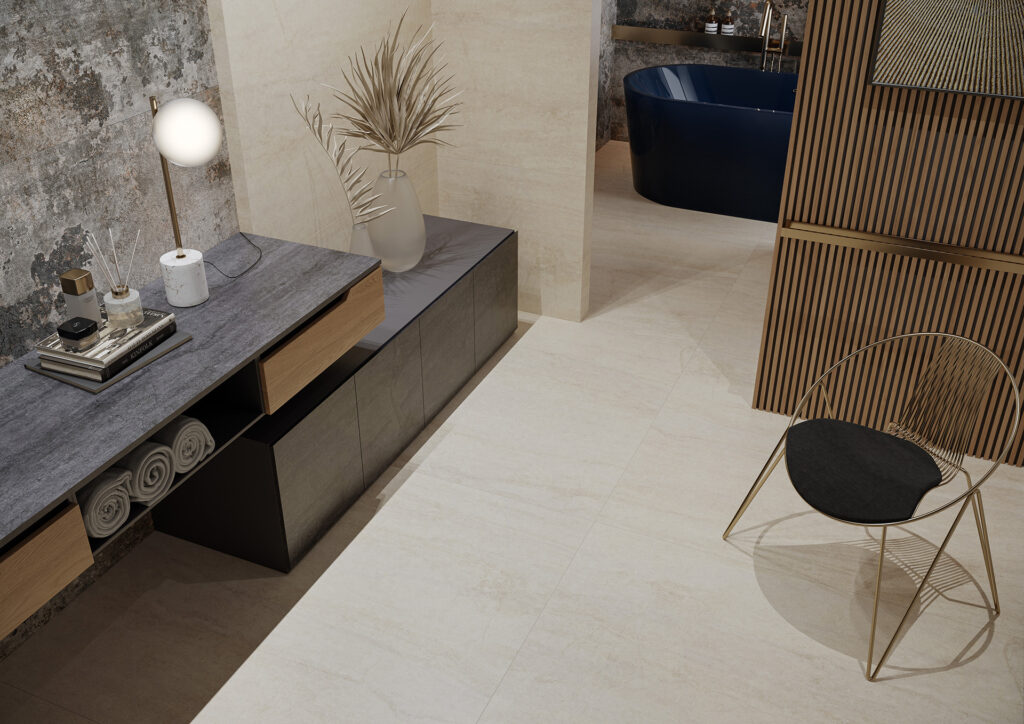
2. Elegant Glamour Bathroom with Marble-Effect Tiles
The Cerrad x La Mania Home collection offers marble-inspired tiles that are perfect for elegant bathrooms. Combined with golden accents – faucets, mirrors, and lamps – bathroom tiles create a glamour-style interior. Large tile formats, such as 120×280 tiles, add elegance and visually enlarge the space.
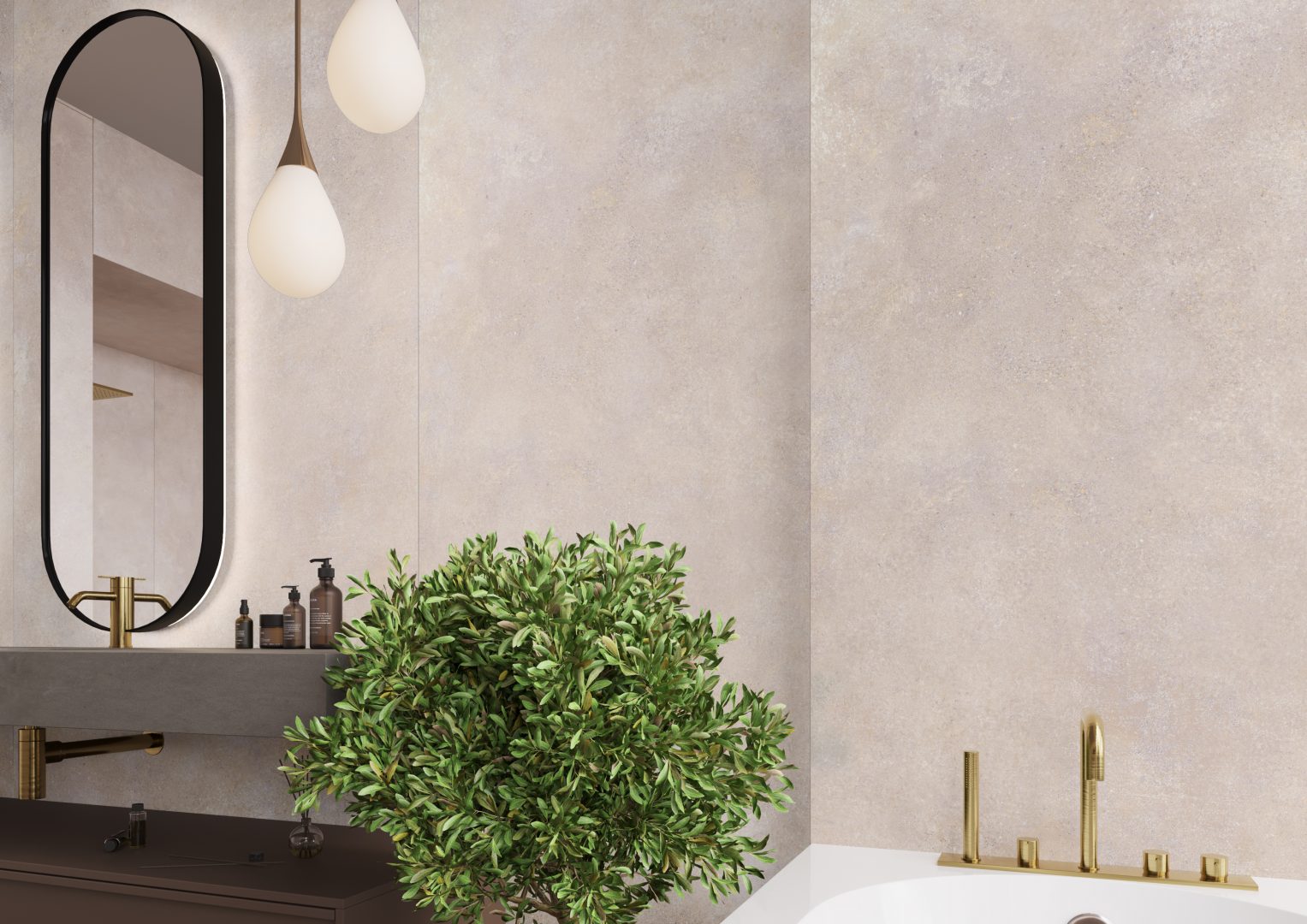
3. Scandinavian Style with Beige Tiles
Beige wall tiles blend perfectly with wooden elements, creating a Scandinavian-style bathroom. Wood-effect Cerrad tiles are an excellent choice for a hygge-style bathroom, where coziness and simplicity reign. Natural materials, wooden furniture, and light beige tiles will create a cohesive, harmonious whole.
4. Modern Bathroom with Large Tiles
For a modern effect, large-format Cerrad tiles, such as 60×120 wall tiles, are a great choice. Combined with mirrors and glass, tiles create an elegant and spacious bathroom. Large-format stoneware is not only aesthetic but also functional – easy to clean and durable for years.
A beige bathroom is a classic solution that, thanks to the wide range of Cerrad and Cerrad x La Mania Home tiles, can be adapted to different interior styles. Whether you dream of a minimalist bathroom, a luxurious glamour interior, or a cozy Scandinavian space, beige tiles – including the elegant Dignity Beige and Modern Concrete Beige collections – provide a perfect base for realizing each of these visions.
Mediterranean-Style FaçadeThe unique Mediterranean style, which practically smells of sand, sea breeze, and vacations, is the true essence of joy and relaxation. Interiors designed in this theme offer a wonderful aesthetic experience, but equally intriguing can be the Mediterranean-style façade, giving a building an amazing atmosphere. How can you create it, and what should you use to transform your home into a summer oasis?
What defines it?
Mediterranean style draws inspiration from sunny summer days, simplicity, relaxation, and happiness. This unpretentious yet remarkably elegant architectural style is reminiscent of designs from seaside villages and towns. The Mediterranean interior trend, based on Greek, Spanish, and Italian traditions, captivates with a wide color palette, interesting decorations, and the feeling of open spaces always ready to welcome guests.
This extraordinary design trend is typical of countries around the Mediterranean Sea, which enjoy a particularly mild climate. The architectural style of this region combines simplicity with solutions that bring people closer to nature. Homes are well-lit, and the materials used—especially brown and beige stone—are meant more to cool interiors rather than warm them.
The Mediterranean style is characterized by large spaces, majestic windows, and bright walls and floors adorned with cobalt, azure, and emerald accents, golden decorations, and lush greenery. Interiors designed in this style also feature stone, stunning ceramics, beautiful mosaics, and wooden furniture and decorations. A hallmark of this interior trend is light, airy curtains and the omnipresent earthy tones that give spaces a very natural feel. Interiors are complemented by beautiful woolen carpets, decorative pillows, sculptures, and kilims, while Mediterranean-style façades with eye-catching woodwork appear almost magical.
What defines a Mediterranean-style façade?
The character of Mediterranean house façades is inseparably connected with the features of the hot, coastal climate. Façades are typically white, and sometimes cream, beige, or pastel. The use of such light colors naturally reflects sunlight, helping to reduce interior heat to some extent, and, according to beliefs, it also protects residents from evil.
The roofs and woodwork are highly contrasting—usually cobalt or azure—which creates a phenomenal effect reminiscent of the Smurf village. In the past, old homes in the coastal villa style were built from light stone, but today, traditional building materials are used, and façades are covered with plaster and traditionally whitewashed just before Easter.
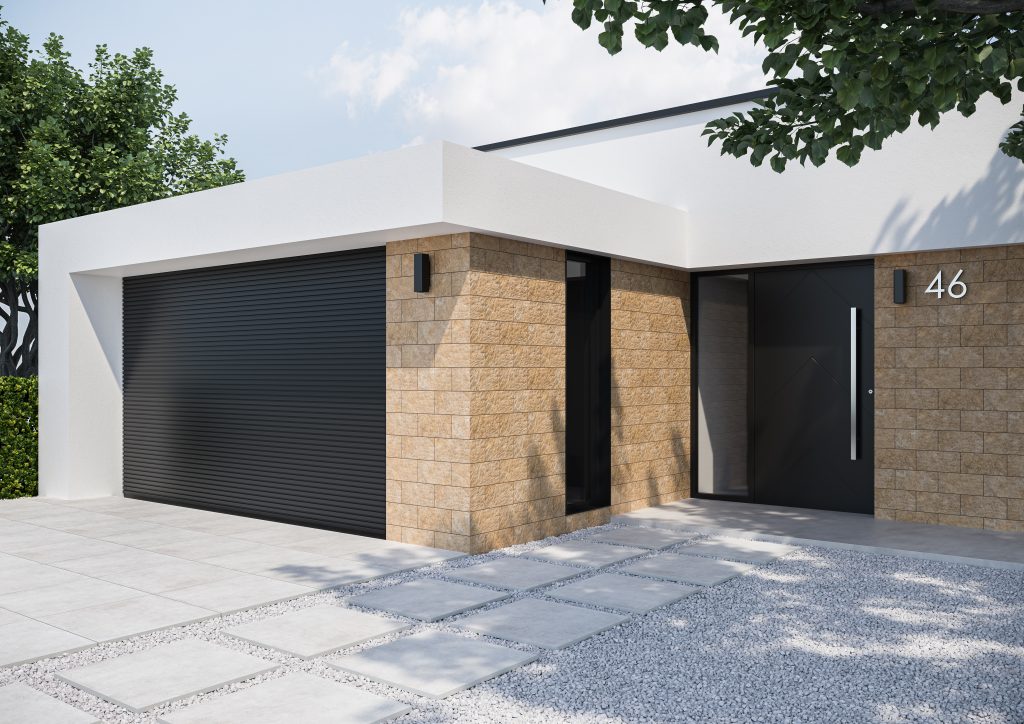
In their most unique form, façades in the style typical of the Mediterranean region feature pastel shades. Warm, burnt browns, beiges, ochres, and sienna are popular. In Polish conditions, few people are ready to opt for such a look for their home, though there is a growing trend of designing summer cottages in this style, serving as a foundation for full-scale projects.
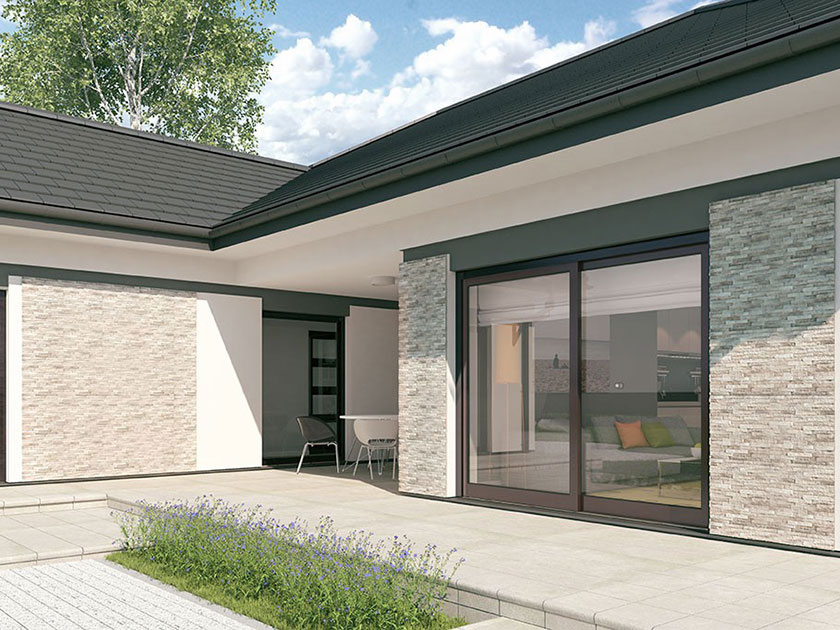
What materials work best for a Mediterranean-style façade?
A Mediterranean-style façade in Polish conditions can be a real attraction. If we take the subject seriously and implement the traditional Greek style, no one will pass by the building without noticing its magnificent design.
The simplest way to achieve a Mediterranean façade is by using light, preferably white exterior plaster, which looks perfect against a light gray roof and woodwork in the same shade, as well as gray or beige exterior tiles. If the owner is bold enough, they can take it a step further and implement the traditional style with its characteristic blue roof and colorful woodwork. In such a case, the best approach would be to choose doors and windows in a bicolor version, with different interior and exterior colors, ensuring that the striking exterior look doesn’t clash with the interior décor.
Decorative elements, such as niches or plinths, are best lined with exterior tiles imitating stone. Wall tiles like Torstone brown with beige decorative mosaics or Canella steel tiles, which look as if they were made from natural cut stone, would be ideal. If the design is to look like it’s made of sandstone, modern Kallio cream exterior tiles are a great choice.
A Mediterranean-style façade comes in many forms. A white base combined with eye-catching blue decorative elements and abundant greenery is the true essence of this beautiful style. It’s worth embracing the Mediterranean trend to refresh your building and give it a joyful atmosphere.
Facade in Scandinavian StyleThe universal Scandinavian style is one of the easiest to implement and has been one of the most popular interior design trends in recent years. Clean, spacious, minimalist, and maximally comfortable, it often becomes the first choice for homeowners and apartment dwellers. Importantly, it can be enjoyed not only inside but also in the form of a Scandinavian-style facade. What are its main features, and where is it best suited?
What Defines the Scandinavian Style?
The Scandinavian design style is characterized by simplicity, functionality, and the use of light colors. Interiors in this style are bright and very spacious, using muted shades such as white, beige, grays, and various shades of brown. However, accessories often have vibrant colors that give the space an individual character.
Scandinavian style originated from Northern Europe, created in response to the need to bring people closer to nature. This minimalist, natural, and wood-based style works well in a variety of spaces, including small apartments, which often pose a challenge for designers and investors. Thanks to its light color palette, this design trend allows for optical enlargement of interiors, while Scandinavian-style facades exude an elegant charm.
In classic Scandi style, natural fabrics like cotton, jute, and linen, as well as wood, stone, rattan, and wicker, are commonly used, warming up the space and giving it a homely feel. This style can have rustic touches, a hint of boho, and often features a single vibrant color in the accessories, which adds a unique flair to the interiors. Popular choices include turquoise, pink, deep green, or mint.
What Does a Scandinavian-Style Facade Look Like?
The key feature of a Scandinavian-style facade is simplicity. Scandinavian houses are primarily minimalist. Typically, they are simple structures with gabled roofs, in light colors, and decorated with wooden or stone elements. The model Scandinavian house is a single-story, barn-style building with a white facade and a gray or graphite roof. The window and door frames are white or light wood. The base and entrance niches are clad in graphite or gray stone, and any decorative elements are often made of exterior tiles that mimic light wood.
Scandinavian style is not a strictly defined design trend but rather a blend of different trends popular in Denmark, Sweden, Finland, Norway, and Iceland. Typical Icelandic houses were long structures with gabled roofs supported by pillars and doors placed on one of the longitudinal walls. In Denmark, single-story houses with basements and colorful facades were once dominant, while in Sweden, residential buildings were often red with white window frames. Therefore, the term Scandinavian is more of an approximation of architectural trends from Northern Europe rather than a strict definition.
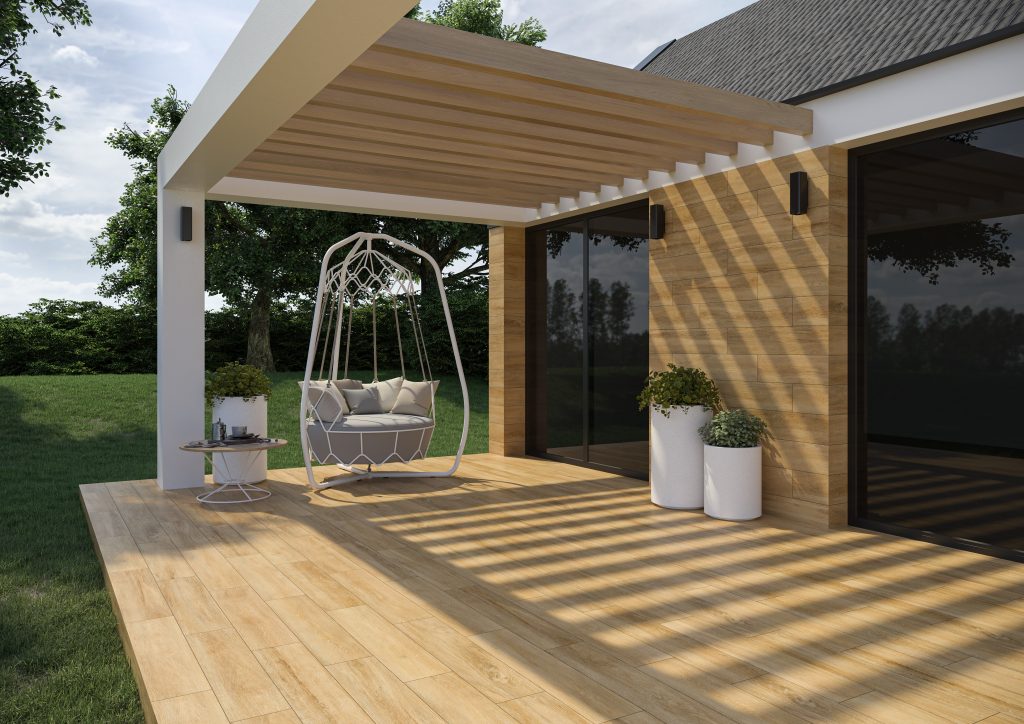
What Materials to Use for a Scandinavian Facade?
The simplest Scandinavian-style facade can be created using white or light gray exterior plaster. Decorative elements, such as around windows or entrance doors, can be enhanced with light wood-effect exterior tiles, such as Aviona Bianco, Listria Bianco, or Mattina Beige.

Wood-effect tiles can also be used for the building’s base. In this case, it is best to opt for a darker model, such as Grapia Ebano exterior tiles or black stone tiles like Tacoma Steel Lapatto. Porcelain tiles can also be used for flooring and finishing the niches of terraces and balconies. They are ideal as a finishing material for pillars supporting roofs. Stone tiles are also worth using in functional spaces like grilling areas or carports.
What Types of Houses Suit the Scandinavian Style?
A Scandinavian-style facade is an ideal choice for single-story modern barn-type houses, as their simple shapes provide a perfect canvas for this architectural trend. Additionally, this style can work well for houses designed in the manner of mountain residences and, of course, in vacation homes. However, it is less suitable for more complex architectural structures.
The concept of a Scandinavian-style facade is broad but can generally be understood as a light design that uses materials imitating natural elements, mainly wood and stone. Uncomplicated, natural, and thus universal, without unnecessary complexities, extravagant decorations, or intricate architectural solutions.
Terrace porcelain tiles – which to choose?The way a terrace is finished greatly impacts not only its aesthetics but also its durability and, of course, how easy it will be to maintain over time. One of the most popular exterior finishing materials today is terrace porcelain tiles, which offer high mechanical and thermal resistance, along with a wide range of colors, patterns, and sizes. How to choose the right porcelain tiles for your terrace and which parameters should you consider?
Terrace porcelain tiles – what are the benefits?
Porcelain is an extremely versatile material known for its remarkable durability, anti-slip properties, and a wide color palette that allows it to be easily matched to personal preferences. Terrace porcelain tiles are wear-resistant and very easy to clean. They withstand heavy mechanical loads, and the passage of time does not affect their aesthetics. Porcelain is highly resistant to abrasion and weather conditions, so difficult outdoor environments pose no threat.
Porcelain is also an extremely safe finishing material, as its rough surface minimizes the risk of slips and falls. The advantages of porcelain tiles for terraces over concrete or wooden planks are clear. This aesthetically pleasing material, with high resistance to dirt and stains, can be easily adapted to any project’s requirements.
Which porcelain tiles to choose for the terrace?
When choosing a finishing material, it’s essential to consider the specific demands of the terrace. This surface is continuously exposed to adverse weather conditions such as extreme temperatures, water, and other precipitation, as well as intense UV radiation. Frost-resistant tiles that can withstand sunlight, abrasion from sand particles, and moisture are essential for finishing the surface.
Typically, ceramic tiles are the first choice for outdoor use, but they often lack the strength to handle future hazards. A much better option is terrace porcelain tiles that meet the appropriate technical standards. Good tiles should have a wear resistance class of 4 or 5 and a Mohs hardness rating of 5-6.
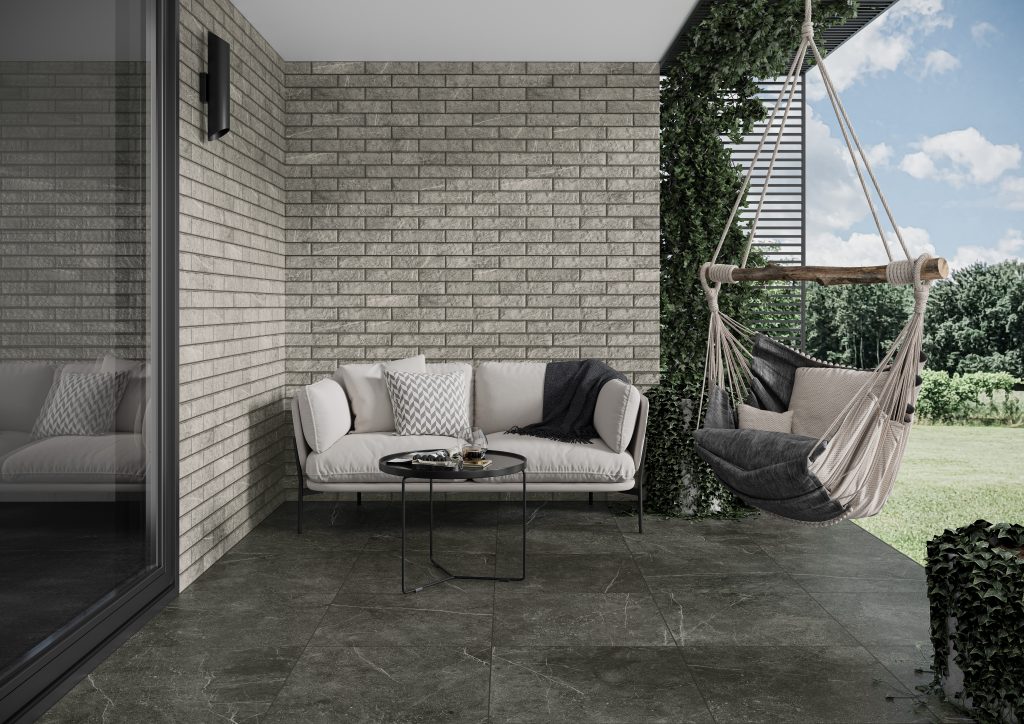
The chosen product must also withstand frost since frost-resistant porcelain is impervious to water, and its low absorption rate prevents it from cracking in low temperatures. The low porosity of porcelain significantly increases its lifespan even in extreme weather conditions.
Choosing the right type of porcelain tile is also crucial. This material is available in porcelain, polished, glazed, and technical versions. For outdoor use, it’s best to choose technical porcelain, as it is very hard and durable, or glazed porcelain, which is further protected from surface damage by a layer of glaze.
Does the color and size of the tiles matter?
The color of the terrace porcelain tiles is just as important as their technical specifications. It should match not only the style of the project but also the preferences of the investor. Outdoors, where the risk of surface dirt is much higher than indoors, it’s best to choose patterned terrace porcelain, and if possible, with a high level of facial appeal. On solid-colored tiles without patterns, all dirt is very noticeable, whereas in tiles adorned with irregular mosaics, dirt particles blend in and are less visible.
The size of the porcelain tiles is purely a matter of personal preference. Small frost-resistant tiles that mimic natural wood look just as attractive as large-format slabs that create a monumental stone design. Size doesn’t always affect the price of porcelain, but it usually determines the time needed for installation. Large terrace porcelain tiles are generally laid faster than smaller ones. They also require less grout, and in the long run, cleaning the joints is faster.
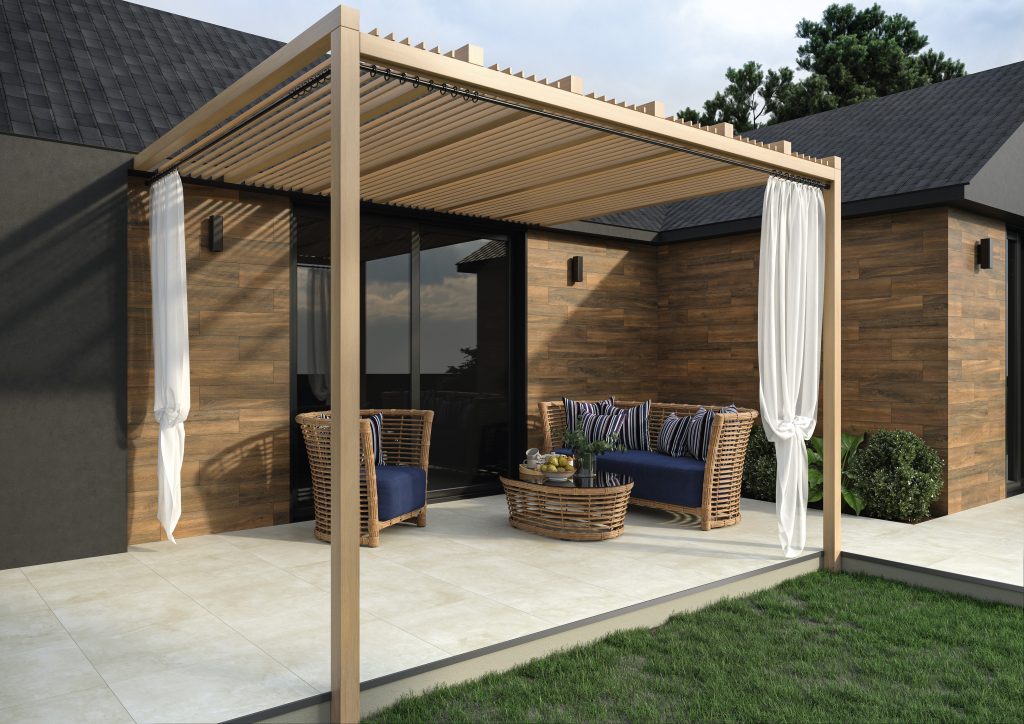
Frost-resistant porcelain – solid color or patterned?
The chosen tiles can mimic any stone, such as sandstone, marble, travertine, or granite. In modern designs, concrete-like models that give a raw floor effect work well – this solution blends perfectly with the simple shape of a building. For traditional homes, wood-like tiles with prominent grain patterns look particularly good. Dirt is also less visible on wood-mimicking tiles, so there’s no need to worry as much about keeping the floor clean.
Choosing terrace porcelain tiles isn’t as simple as it seems, as the multitude of available models can be overwhelming. When purchasing tiles, it’s important to consider a few parameters, primarily the wear resistance class and slip resistance, as well as the type of tile. The brand also matters, as a reputable manufacturer can offer a highly diverse range of solutions and consistent quality, ensuring a uniform surface appearance.
The Coverings 2024 Trade Show is behind us. It’s the largest and the most significant event in the ceramic and natural stone industry in the United States and North America.
From the 22nd to the 25th of April this year, guests visiting the Atlanta held fair could get acquainted with products that are currently setting new trends in the field of finishing and they could also meet with numerous exhibitors from all over the world. It was also an excellent opportunity to find out which direction current trends and the industry’s manufacturers are heading, learn about modern production technologies and explore what steps and measures various companies are taking for pro-environmental purposes for instance.
This is an event with more than 30 years of tradition, which makes it one of the most important and reputable events in the finishing industry. It’s the perfect place to not only showcase the new products in ones portfolio, but to also present innovations in manufacturing practices and to introduce and expand on the brands DNA, their philosophies and business approaches.
More than 1,000 exhibitors from over 40 countries around the world, tens of thousands of visitors and countless examples of excellent global designs – attendance to this year’s edition of the fair meant it was an excellent opportunity to meet the best architects, designers, contractors and investors from around the world, thus learning about the trends that will be coming your way in the upcoming seasons.
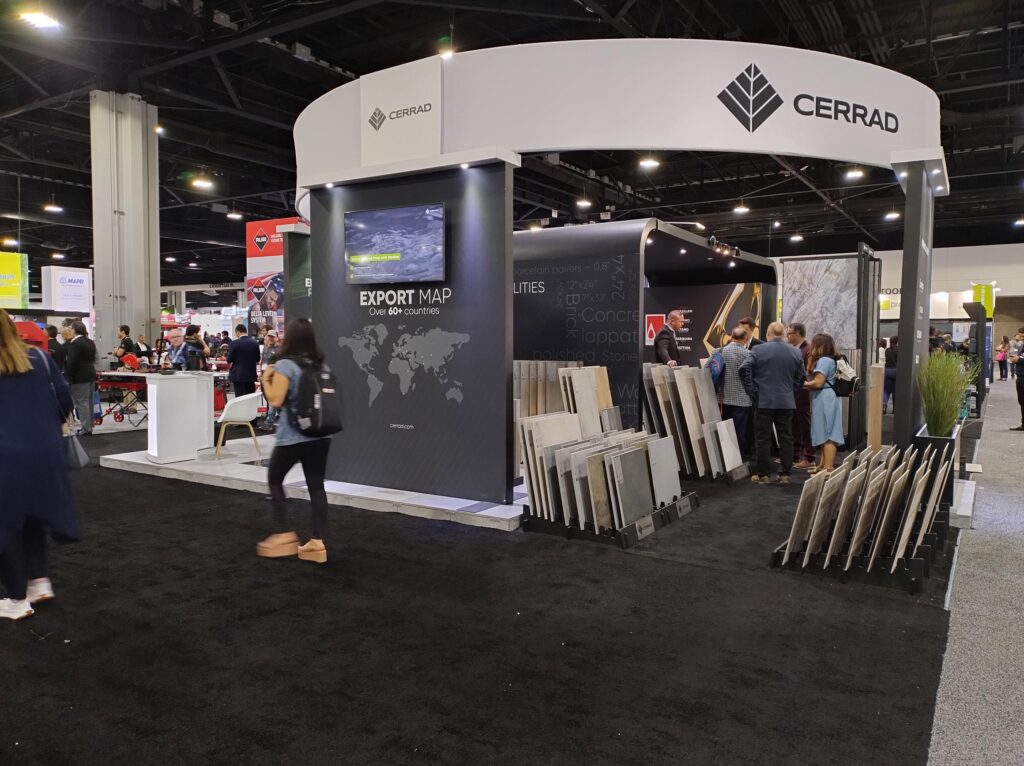
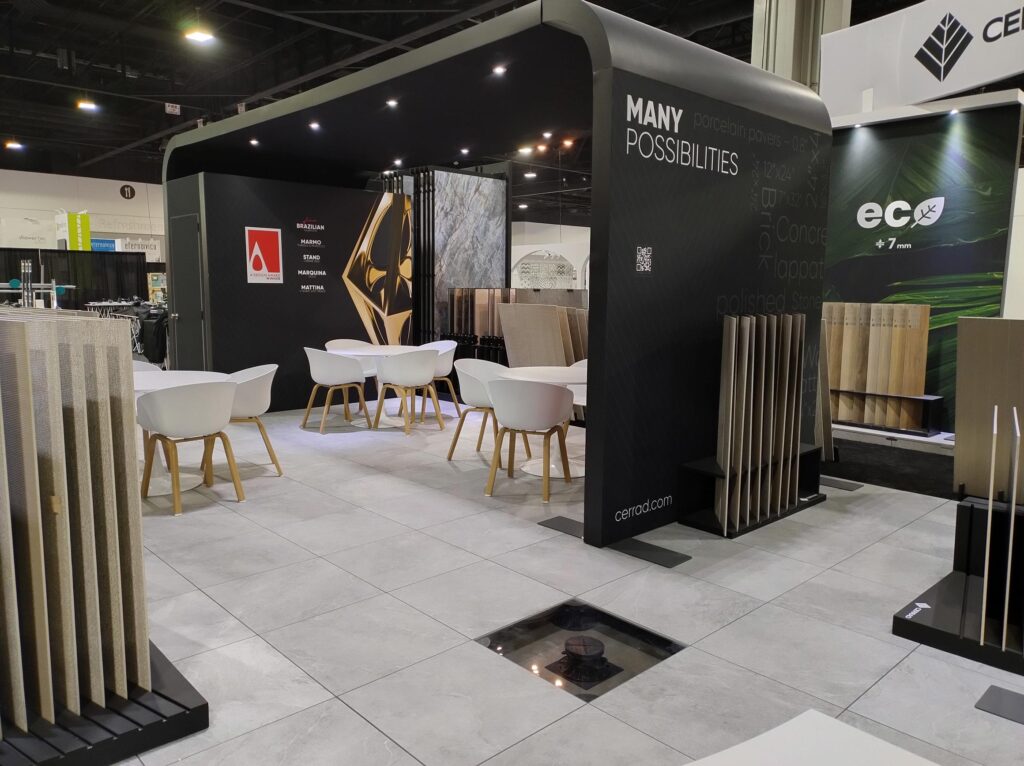
For Cerrad, its presence at the Coverings Fair was a confirmation of the high position that the company has been holding on the global ceramic market for the past several years. The fair was not just an ideal opportunity to acquaint the visitors with our comprehensive product offer. The location of our booth in the main aisle of the TCNA (The Tile Council of North America) section dedicated to American tile manufacturers, confirmed our ambitious plans for growth and further development in this exciting market.
We would like to sincerely thank all the visitors and guests for the multitude of inspiring meetings and conversations.
The year 2023 brought with it an innovative approach to the use of dark ceramic tiles in various spaces. They dominate as wall elements in kitchens creating a distinctive backdrop for modern appliances and contrasting with light countertops and cabinets. In bathrooms, graphite becomes synonymous with luxury, especially when combined with accents such as gold or copper fittings. Dark tiles add depth and character to the space, while maintaining a feeling of freshness.
In living rooms, graphite tiles often show up as decorative accents or as flooring, introducing a modern and elegant look into the interior. Furthermore, in commercial spaces such as offices, hotels and restaurants, graphite tiles are valued for their durability and easy cleaning, while adding professionalism and a modernity to the space. Regardless of the location, dark tiles are becoming the key to creating places that are functional, stylish and trendy all at the same time.
Graphite ceramic tiles gained popularity in recent years, when minimalism and modernity became key trends in interior design. The graphite color, a combination of deep black and subtle gray, has become synonymous with elegance and modernity. Modern technologies helped to create products with various textures and patterns, which has additionally enriched the range of design possibilities. Today, graphite ceramic tiles are not only a testimony to the evolution of interior design, but also a reflection of our need to combine tradition with modernity.
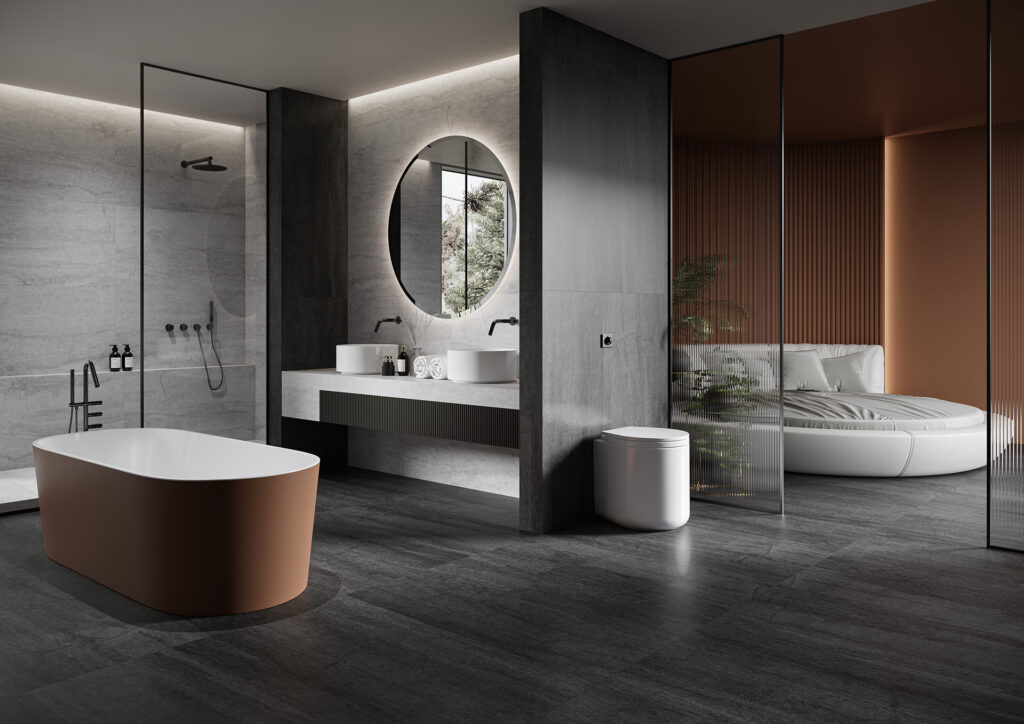
Why is graphite always trendy?
In the world of interior design, where colors and materials are constantly changing, graphite ceramic tiles are gaining recognition as a timeless choice for many spaces. One of the main reasons for their popularity is the universality of this particular color. Its deep, but at the same time subdued shade, fits perfectly into contemporary trends combining minimalism with refined elegance. Graphite is a color that can easily be combined with other color palettes allowing you to create coherent and harmonious spaces. It goes perfectly with many other shades, therefore, you can come up with extremely interesting color combinations. Light colors such as white, beige or various pastels become the perfect backdrop for graphite tiles, adding lightness and freshness to the interior. In turn, when combined with stronger colors, such as navy blue, burgundy or deep green, the tiles create expressive and bold contrasts that catch the eye. Graphite ceramic tiles also harmonize perfectly with metallic accents – gold, copper or chrome adding luxury and shine to the space. For those who are looking for more subdued and natural combinations, graphite goes well with wooden elements and green plants. Such combinations create a warm and cozy atmosphere, perfect for relaxation. It’s this versatility of graphite that makes it so valued in interior design, allowing you to create spaces tailored to individual needs and tastes.
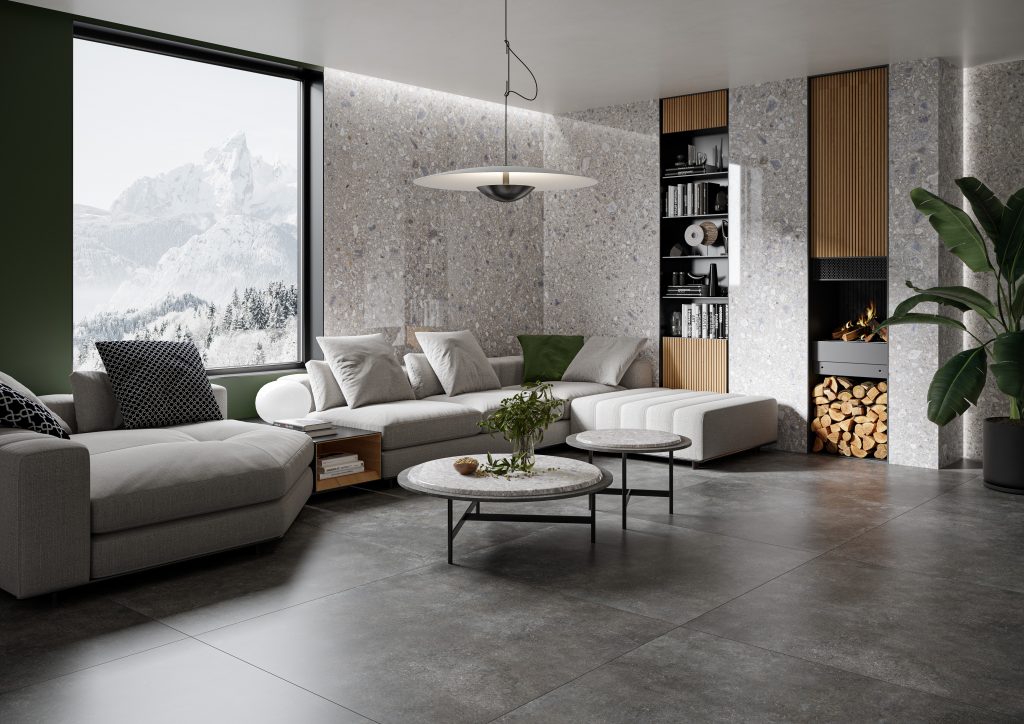
Different rooms, different uses, different shades
In the kitchen, graphite ceramic tiles are becoming more and more popular not only as wall finishes above countertops, but also as flooring and even decorative elements on cabinet fronts. Their resistance to getting dirty, ease of cleaning and elegant appearance make them an ideal choice in a place where functionality integrates with aesthetics. Combined with light cabinets, wooden countertops or steel accents, graphite tiles add a modern, but at the same time warm character to the kitchen. In the living room, graphite tiles can serve as a backdrop for a fireplace or TV, or as flooring or an added floor element, creating a contrast with light furniture or colorful carpets. They can also be used to finish shelves or niches where favorite items are displayed. This solution, together with the use of LED lighting, will allow you to achieve a really interesting effect. In the bathroom, graphite tiles are not just used on walls and floors or to finish the shower or bathtub, but also on ceilings (as a mosaic for example). So, it may seem like architects these days are falling head over heels for innovative designs that they can present to their clients.
Combined with light grout lines, chrome or gold fittings and green plants, they can create a space that is both elegant and relaxing. Furthermore, graphite goes perfectly with wooden elements in the hallway or the bedroom, creating a coherent and harmonious whole. Regardless of the room, graphite tiles offer countless design possibilities that respond very well to contemporary needs, while making sure that they emphasize the individual character of each space.
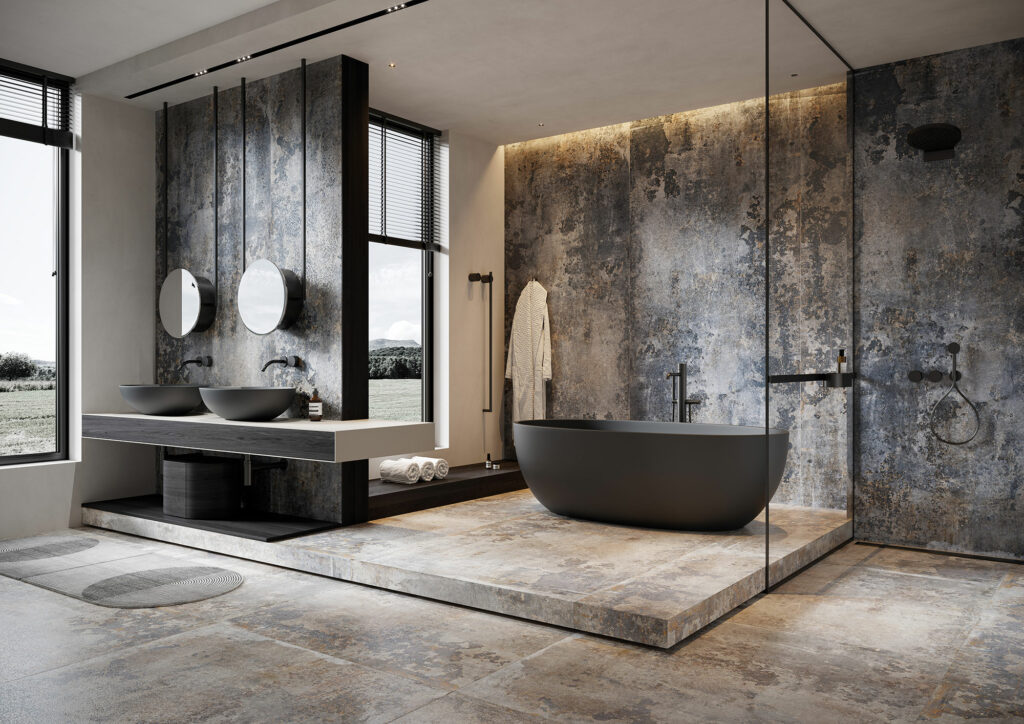
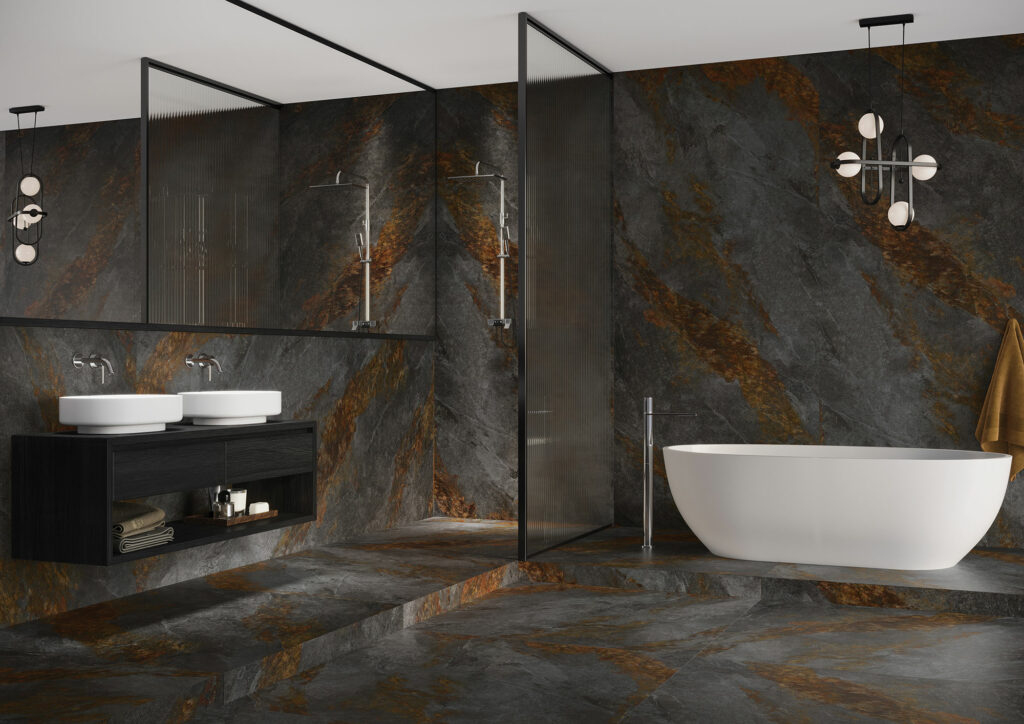
The future of graphite ceramic tiles
In the dynamically changing world of interior design, it’s difficult to predict which trends will go on and which will disappear in the blink of an eye. However, graphite ceramic tiles, thanks to their universality and versatility, have all the advantages to remain one of the top choices for designers for years to come. The growing interest in durable and ecological materials may additionally contribute to the tiles keeping their popularity, since they’re not only aesthetic, but also durable and recyclable. While it’s difficult to predict the exact direction future interior design trends will take, graphite ceramic tiles, thanks to their numerous advantages, are unlikely to fall off of our radar.
Ideal gres tiles for a modern office floorModern offices are not just workplaces, but more importantly spaces that inspire, motivate and foster creativity. In the era of dynamically developing interior design trends, the selection of suitable finishing materials is becoming the key element in creating office interiors with a unique character. Gres tiles, thanks to their versatility, durability and aesthetics, perfectly fit the needs of modern office spaces, becoming one of the most frequently picked materials for floors.
Trends in floor arrangement for modern offices
More often than not, modern offices are becoming a place where design goes hand in hand with functionality. Among the trends dominating office floors, large format tiles are at the forefront. These grand, often square or rectangular shapes, add modernity and a sense of openness to the interior. Likenesses of natural materials, such as wood or stone, continue to be popular, combining the warmth of natural raw materials with the durability of gres. Geometric patterns, whether in the form of tiles or arranged in interesting mosaics, become an expressive decorative element, emphasizing the character of the company. Creativity, expressed in the form of fish scales or hexagonal patterns for instance, allow you to create unique compositions that are not only aesthetic, but also reflect the brand’s innovation. The office, being the company’s showcase element, should have every detail, even the smallest one like the arrangement of tiles paid special attention to, as it is very important in building a positive image of the brand – in the eyes of employees and customers alike.
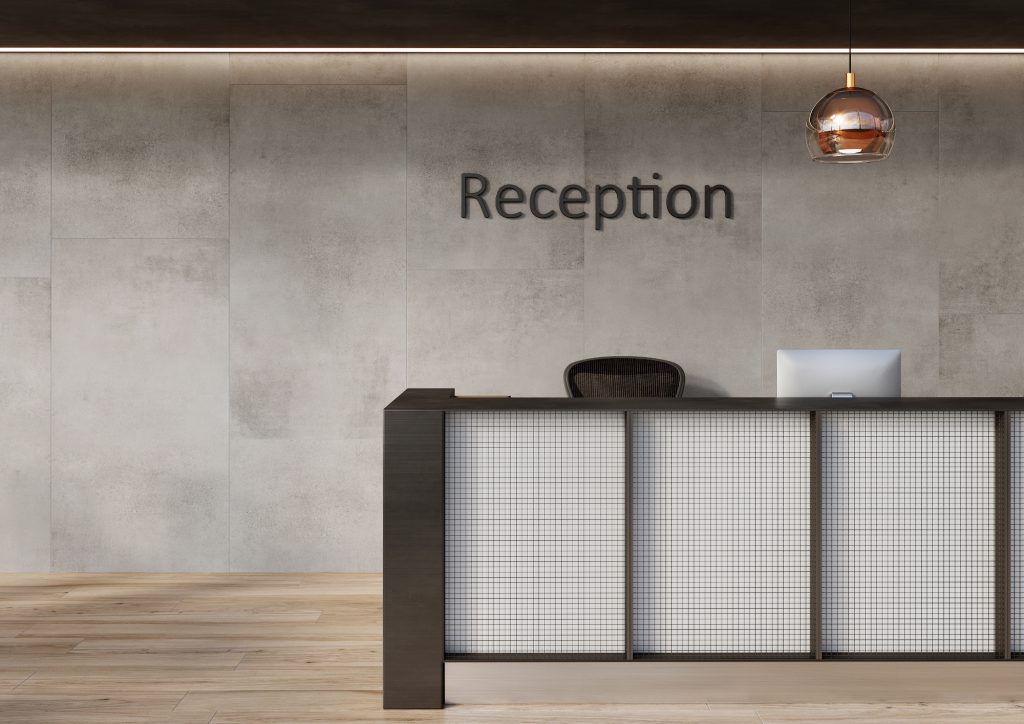
Why gres tiles?
Gres is a material that has been enjoying continuous popularity among interior architects and designers for years. But what makes it such a popular choice for office spaces? First of all, gres tiles are characterized by extraordinary durability and resistance to abrasions, which is priceless in high-traffic places, such as offices. Additionally, their surface is easy to keep clean, which is particularly important when employee hygiene and health are a factor. Porcelain gres does not stain, which means that even an accidental coffee or tea spill won’t be a threat to it. The wide assortment of colors and patterns allows you to create unique arrangements that reflect the company’s character and create a friendly environment for its employees. These features make gres one of the most practical and aesthetic flooring solutions for modern offices.
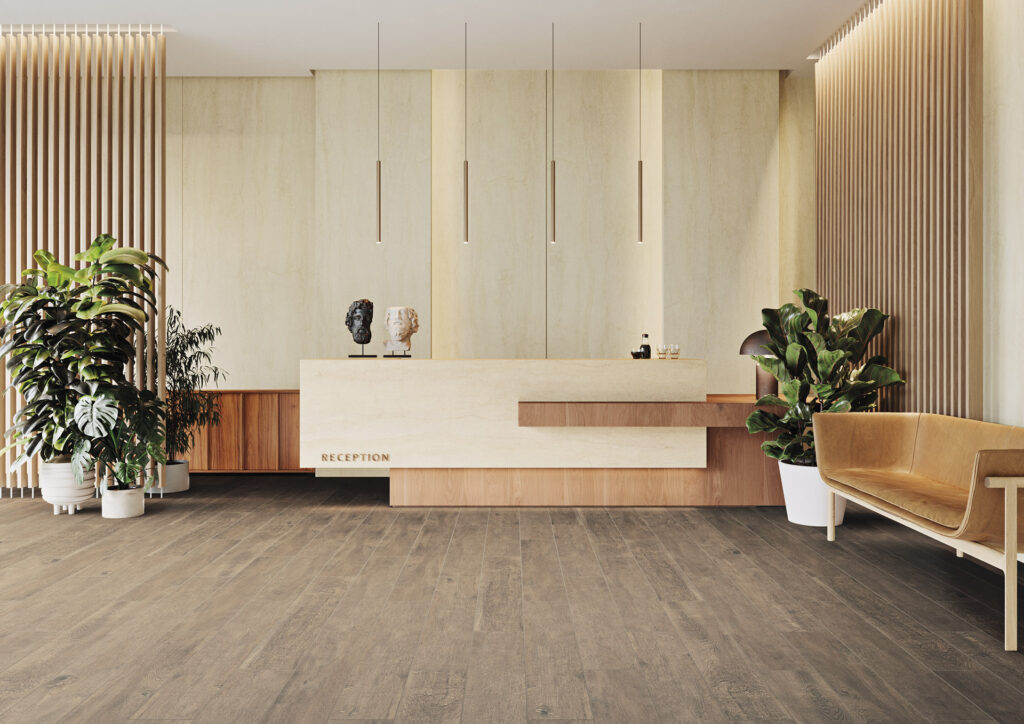
Gres tile types that are ideal for an office
When deciding on an office floor, it’s worth paying attention to several key aspects that determine its functionality and aesthetics. One of the most popular choices are polished gres tiles, which delight with their mirror-like shine, adding elegance and a modern character to the interior. For those who are looking for a more subdued effect, the ideal solution will be matte gres, which is subtle and universal. We also can’t forget about structural gres, which thanks to its unique texture adds depth and originality to the space. The palette of colors for gres tiles is extremely rich – from classic, neutral shades of white and gray to more bold and expressive colors that can become the main decorative accent of the office. Choosing the right type and color of tiles allows you to create an interior that will not only be functional, but above all, will reflect the character and values of the company. We’re happy to recommend several suggestions from our offer, like the universal and timeless concrete structure expressed in the Cencrete Gris tiles for example, which have excellent anti-slip properties.
Proximity to nature calms us down and promotes concentration, which is extremely important in office spaces, that is why our next suggestion are the Guardian Wood tiles. On the other hand, the warm shade of sandstone look very good in contrast with cool, white walls, so the Dignity Beige tiles are also an ideal solution.
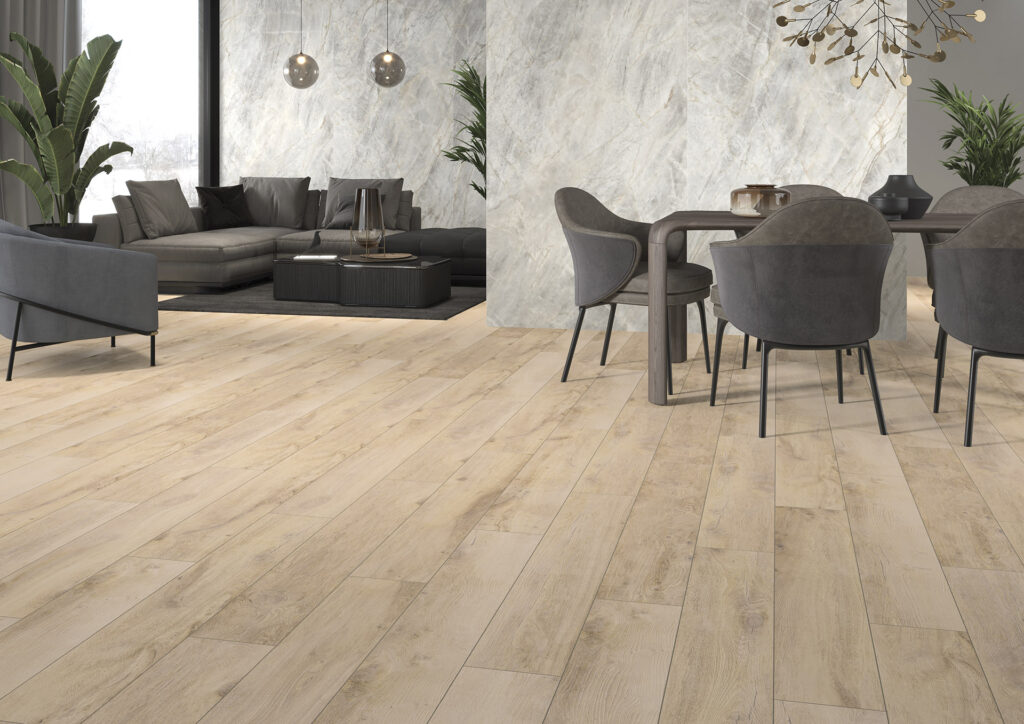
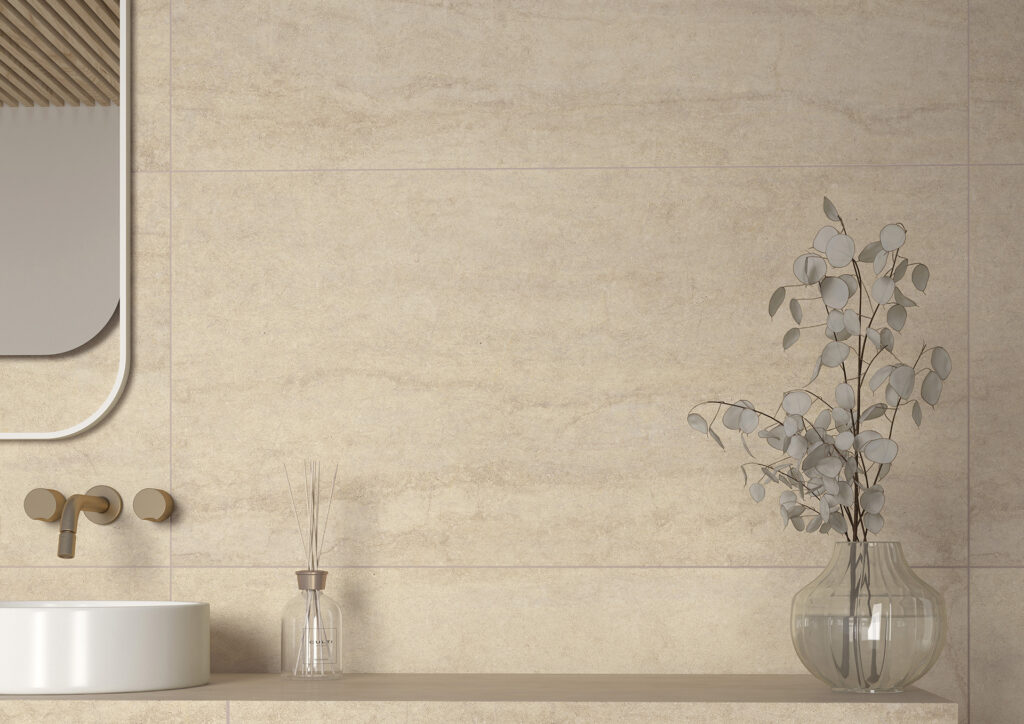
Key criteria to check when selecting gres tiles for the office
When choosing gres tiles for your office, you can’t simply rely only on their appearance. There are several key criteria that should be taken into account to ensure the comfort and safety of office users. First of all, it’s important that the tiles have good anti-slip properties. Offices are places utilized by many people every day, and the risk of slipping, especially in the autumn and winter, is quite significant. Resistance to mechanical damage is another crucial aspect – the office floor is prone to the effects of office chairs being moved around, frequent shifting of furniture and falling objects, therefore, it’s worth paying attention to the tile’s abrasion class. Ease of keeping clean is also a valid concern, so the gres tiles should be stain-resistant and easy to clean. Ultimately, aesthetics and matching the tiles to the office style are what will determine the final appearance of the space. When choosing gres tiles, it’s worth combining practicality with aesthetics to create a space that is both functional and representative of the brand.
Choosing the right gres tiles for a modern office is a task that requires not only an aesthetic sense, but also a practical approach. As we have shown gres offers a wide range of possibilities both, in terms of design and when it comes to functionality.





 Tyto stránky používají soubory cookies pro vylepšení dojmu při pohybu po webových stránkách. Mezi nimi jsou soubory cookies, které jsou kategorizovány jako nezbytné, jsou uloženy v prohlížeči, protože jsou nezbytné pro fungování základních funkcí webových stránek. Používáme také soubory cookies třetích stran, které nám pomáhají analyzovat a pochopit, jak používáte tyto webové stránky. Tyto soubory cookies budou uloženy ve vašem prohlížeči pouze s vaším souhlasem. Máte také možnost zamítnout tyto soubory cookies. Avšak zamítnutí některých z těchto souborů cookies může mít vliv na pohodlí při prohlížení.
Tyto stránky používají soubory cookies pro vylepšení dojmu při pohybu po webových stránkách. Mezi nimi jsou soubory cookies, které jsou kategorizovány jako nezbytné, jsou uloženy v prohlížeči, protože jsou nezbytné pro fungování základních funkcí webových stránek. Používáme také soubory cookies třetích stran, které nám pomáhají analyzovat a pochopit, jak používáte tyto webové stránky. Tyto soubory cookies budou uloženy ve vašem prohlížeči pouze s vaším souhlasem. Máte také možnost zamítnout tyto soubory cookies. Avšak zamítnutí některých z těchto souborů cookies může mít vliv na pohodlí při prohlížení.